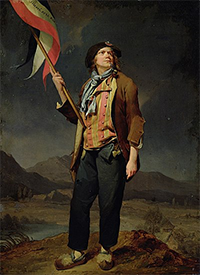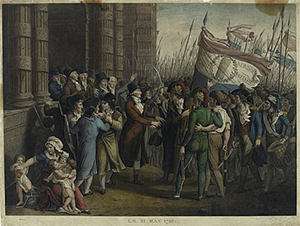The Sans-culottes of France
The sans-culottes were the working-class people who made up the majority of the great crowds that participated in most of the major events of the French Revolution. 
The name came from the clothing that they wore–actually, from the clothing that they didn't wear. The nobility at the time wore culottes, or silk breeches (or britches) that came down to the knee but no further. The commoners/peasants wore pantalons, or long pants/trousers, and so did not wear culottes. These people also commonly wore a distinctive short jacket called a carmagnole and at times a red hat known as a liberty cap. A great many of the sans-culottes spoke out, with words and deeds, in favor of greater equality, for themselves and for other people. The quality of life of peasants under the Ancien Régime, of which they were the Third Estate, was not high in many cases. Members of the First Estate (clergy) and the Second Estate (nobility) were usually exempt from tax laws and military service requirements. By and large, sans-culottes were the more radical members of the Third Estate, seeking true equality through the abolition of privileges that they didn't enjoy; this sort of agenda naturally targeted clergy, nobility, and the royal family, who benefited from such things. One of the main campaigns of sans-culottes was to fix or otherwise control prices. A series of poor harvests had resulted in a rise in the price of grain without a matching rise in wages, and so essentials such as bread were effectively much more expensive. Bread riots were not uncommon, and the response of the royalty in particular but also the nobility was not always sympathetic. 
Sans-culottes were part of nearly every major uprising in the French Revolution, providing the manpower and the muscle during the Storming of the Bastille and the Storming of the Tuileries Palace, as well as filling the numbers in the National Guard and the Republican army, as more and more European (monarchical) neighbors fought against a France determined to pursue a more democratic form of government and society. Most comprehensively, sans-culottes made up a large part of the crowd that ringed the Legislative Assembly meeting in August 1792 and forced that body into doing away with the monarchy. In the same vein but much more darkly, sans-culottes invaded Paris's prisons in September 1792 and executed those known to have opposed the Revolution. Sans-culottes served as deputies in the various lawmaking bodies of the Revolution and the Republic but, for the most part, preferred to remain outside political circles, believing that they had more influence that way. They also stopped using titles like Monsieur and Madame in favor of Citoyen and Citoyenne ("Citizen"). The influence of these determined revolutionaries was so great that in some cases members of the nobility showed their support for the sans-culottes by adopting their clothing scheme. Despite this, as extremely radical elements rose to the fore at the beginning of the Reign of Terror, Maximilien Robespierre took measures to minimize the influence and power of the sans-culottes. Revolutionary tribunals ordered the arrests of leaders such as Jacques Hébert and then had them executed as enemies of the state. Once the Directory took hold, the sans-culottes found themselves sidelined for good.
|
|
Social Studies for Kids
copyright 2002–2025
David White




